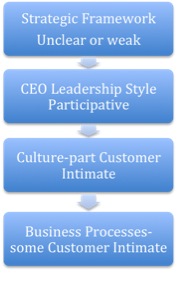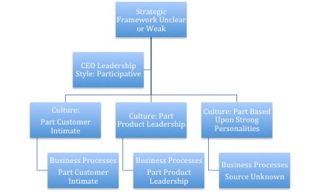Most Common Mistakes That CEOs Make: Ignoring Alignment

I am amused by comments that I hear and read about Apple and it’s leadership. For example:
- “They need to do more research and ask for customer input.”
- “They are arrogant.”
- “Steve Jobs was a perfectionist and maniac about his products. He was always challenging his employees to do more. He was never satisfied.”
Apple excels at aligning it’s business with it’s strategic framework, and the above comments illustrate the common ignorance about this subject. Unlike Apple, most businesses ignore alignment, letting their processes and culture evolve, and then they wonder why their results are disappointing.
The Starting Point: Strategic Framework
Let’s start with the definition: a strategic framework is the way your company creates value for your customers. It is the starting point in designing your business model, and it establishes the foundation from which you align your leadership style, culture, management systems and business processes.
In their book “The Discipline of Market Leaders: Choose Your Customers, Narrow Your Focus, Dominate Your Market”, Michael Treacy and Fred Wiersema refer to three strategic frameworks:
- Operational Excellence (best price) focuses on delivering a combination of quality, price and ease of purchase that no other company can match. Its propositions to customers are guaranteed low prices or hassle-free service. Low price is the focus of most operationally excellent companies, like Wal-Mart. It is not, however, the only way in which the total cost of a product can be kept low. Reliability and durability are also factors that affect the total cost of a product.
- Product Leadership (best product) focuses on providing innovative, leading edge products that continually redefine markets and raise standards in its industry. Product Leadership companies may not be the original inventor. They may intentionally choose to let others work out early bugs in new technologies and then leapfrog early generations with a new version.
- Customer Intimacy (best solution) focuses on selling the customer a total solution, not just a product or service. This means that while they don’t necessarily have the lowest prices or the latest product features, they offer better overall results for customers by attending to a much broader range of their needs. They personalize basic services and customize products to meet unique customer needs.
Apple- A Role Model For Alignment
Apple is a “Product Leadership” company producing a steady stream of cutting-edge products and services, and it is such a well-known story that I am going to use it to illustrate my point about alignment.
First, let’s look at the attributes of a “Product Leadership” company. Remember, a “Product Leadership” company produces superior products and services and knows how to get customers to pay premium prices for them. They know how to time new product releases and are experts at managing prices over a product’s life cycle. New products are launched with fanfare and hype. A key to their ongoing success is driving their own products into obsolescence with a newer version when the time is right.
Culture:
Culture is how the employees and leadership of a company behave. Each strategic framework requires a specific culture. The “Product Leadership” culture is conceptual, competitive, future-driven, entrepreneurial and risk-oriented. Employees of these companies must think creatively and work long hours. They bond through their ideas, concepts and tasks.
Because “Product Leadership” companies must act quickly to convert the latest idea into a final product, they require a fluid organization. Cross-function teams are their primary management structure, and they are sometimes set up to intentionally compete with each other. Information, expertise and knowledge are highly valued, and the employees that demonstrate their competency in these areas succeed. This culture often produces technical experts, superstars, heroes, mavericks and a meritocracy. At its extreme, this culture can be described as irreverent, combative, impersonal, undisciplined and disrespectful.
Core competencies:
“Product Leadership” organizations must be expert at:
- Creativity– the ability to invent something new.
- Innovation– the ability to quickly execute and commercialize new products and ideas.
- Disruptive technology– the discipline to make their own products obsolete before their competitors do.
Leadership:
This may sound obvious, but I’ll say it anyway: The CEO sets the culture of his business by what he does and does not do. For ideal alignment, the leader has natural traits that produce the desired culture. What kind of leader is needed to create the culture and core competencies described above? One who:
- is constantly raising standards and expectations. As a result, he may always appear dissatisfied.
- inspires employees to work harder and better.
- has a sense of urgency.
- creates constructive tension and competition.
- loves a challenge.
- is a visionary.
- believes that ideas and concepts motivate others.
- is a strategist.
- is future oriented.
Management systems:
Flexible and fluid management systems must support the need to quickly commercialize entrepreneurial opportunities. Therefore, Project Managers who lead cross-functional teams are key management positions. These Project Managers must have the autonomy to select members for their teams based on expertise and competence. Groups are regularly formed, disbanded, and then reformed for new projects. Project Managers must be skilled in setting clear directives and making tough decisions with the Executive Leadership so that quick and efficient decision making can be balanced with thorough analysis.
Human Resources and Performance Management:
People systems promote the key concept that both individual and company successes happen when they outperform their last challenging invention.
Human Resource’s primary directive is finding talented employees; especially those individuals who like increasing their expertise, are autonomous, are opportunity driven and support the company’s theories and concepts. Talented people are further developed by participating in difficult, yet achievable assignments. These expert employees crave feedback (it helps them improve), and it is frequently given.
Positions are broadly defined, which leaves room for individuals to adjust to rapidly changing projects and deadlines. Job titles and specific roles have little importance.
Success, when compared against the high standard of excellence, is rewarded. A significant portion of an employee’s compensation is variable, with proven top experts receiving the highest rewards. The ultimate measure of individual recognition is being selected to tackle the company’s next great challenge.
Business processes and systems:
Just as management systems need to be loose and flexible, business systems must also adjust to ever changing entrepreneurial initiatives. Resources are deployed to the project that has the best chance for success. Treacy and Wiersema found that “Product Leadership” companies create robust processes around these principles:
- Keeping people on track by organizing the work in a series of well-paced challenges, each with a clearly defined outcome and tight deadline.
- Creating business structures that don’t oppress or break entrepreneurial spirit.
- Stressing procedure where it pays the biggest dividend, which is usually during the final leg of the product development cycle.
Apple’s Alignment
Now that you understand the components of alignment within the context of a “Product Leadership” framework, let’s review how well Apple did after the return of Steve Jobs:
- They had a clear strategic framework (“Product Leadership”) which aligned with
- the natural leadership style of the CEO, which created
- a conceptual, competitive, future-driven, entrepreneurial and risk-oriented culture, which aligned with the
- management systems and business systems which worked together.
Graphically, alignment should look like this:
The Common Mistake:
Unfortunately, the mistake I see too often is that the CEO and Senior Executives of a company are unaware of their own strategic framework. Business and management processes just evolve, mostly because of strong personalities (aka “Stuffed Shirts”), or fear of being sued. As a result, this weak strategic framework actually ends up competing with a set of processes and systems that contradict it!
Diagrammatically, it looks like this:
Now, look at the comments in the first paragraph through the lens of the strategic framework. Of course Steve Jobs was always raising the bar and driving his people hard. Apple is full of experts, and experts often appear arrogant. In this context, not only do they make sense, but they are necessary for a “Product Leadership” strategic framework!
Too often, CEOs and Senior Executives try to implement best practices or the newest management trend while ignoring what their own strategic framework dictates. Not surprisingly, misalignment happens.
The good news is that you can re-align your business. Start by selecting a clear strategic framework. If necessary, adapt your own leadership style to create a behavioral-based culture that is consistent with your chosen framework. Finally, be very intentional about designing your supporting management systems and business processes. Actively look for those that contradict each other, and eliminate barriers to performance. Expect that this whole process will take 2 to 3 years.
Regardless of what you think of Steve Jobs, he was an expert on focus, and he concentrated on creating an aligned organization using a “Product Leadership” strategic framework. It will be interesting to see if Jobs’ successor, Tim Cook, who has a very different personality, will be able to maintain the same strong alignment.
_____________________________________________
By Cheryl B. McMillan. Cheryl leads four high performing groups in Northeast Ohio. This is the latest in a series of blogs about the most common mistakes that CEOs make.
Category : Leadership



